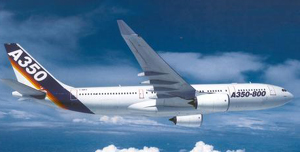
 Pourquoi Boeing déterre la hache de guerre (A350)
Pourquoi Boeing déterre la hache de guerre (A350)  Why Boeing is on the warpath again
Why Boeing is on the warpath again
En effet, la Compagnie de St Louis a l’intention de déposer un recourt à l’OMC, avec l’appui de George Bush, à l’encontre d’Airbus pour concurrence déloyale concernant les avances remboursables consenties par les Etats européens.
Pourtant en 1992 les deux avionneurs avaient passé un accord globalement respecté par les deux parties.
Alors, pourquoi ce discours véhément ? En raison du succès de l’A380, un long-courrier de 500 places ? Non, puisqu’il n’est en aucun point concurrent du Boeing 7E7, un long-courrier de 220 places.
Rappelons que pour la première fois dans l’histoire de l’industrie aéronautique, Airbus est passé devant Boeing en terme de ventes et de production d’unités en 2003, et 2004 prend la même direction. A noter également l’abandon du projet du Super Jumbo, défunt concurrent de l’A380. Donc Boeing mise tout sur le lancement en 2008 du 7E7 « Dreamliner » pour reprendre le leadership.
passé devant Boeing en terme de ventes et de production d’unités en 2003, et 2004 prend la même direction. A noter également l’abandon du projet du Super Jumbo, défunt concurrent de l’A380. Donc Boeing mise tout sur le lancement en 2008 du 7E7 « Dreamliner » pour reprendre le leadership.
C’est pourquoi quand Airbus parle de mettre sur le marché un long-courrier de 280 places (60 de plus) pour une sortie au plus tard en 2008, Boeing voit rouge.
Et c’est là qu’entre en scène l’A350, une évolution de l’A330, avec un rayon d’action accru jusqu’à 14500 km (comme le 7E7), du matériel composite un peu partout et les mêmes moteurs économiques que son rival.
Cela explique la rupture récente des négociations pour l’achat de 7E7 de la compagnie Qatar Airways et les foudres de Boeing.
Noël Forgeard, le président D’Airbus s’est donné 10 ans pour dépasser son rival américain, on constate qu’il s’en donne les moyens.

Meudon , 13 September 2004
 Why Boeing is on the warpath again
Why Boeing is on the warpath again
The company from St Louis intends to appeal to the WTO, against Airbus, with George Bush’s support, for unfair competition concerning the refundable advances authorized by the European states.
Yet in 1992 the two manufacturers had signed an agreement, which had been respected overall by both.

So, what is the reason for this aggressive stance? Is it the success of the 500-seat long-distance carrier A380? Not so: the A380 is no longer a competitor for the Boeing’s 220-seat long-distance carrier 7E7.
It is worth reminding that for the first time in the history of the aircraft industry, Airbus was ahead of Boeing in terms of sale and production in 2003, and 2004 is taking the same direction. Another factor is the abandon of the US Super Jumbo Jet project, a late competitor to the A380. Thus Boeing is placing all its hopes on the 7E7 "Dreamliner" schedule in 2008 to regain leadership.
This is why, Airbus is talking about marketing a 280-seat long-distance carrier (i.e. with 60 extra seats) by 2008, Boeing is infuriated.
Enter the A350, evolved from the A330, with an increased 14,500 km (9,000 mile) range (like the 7E7), composite material everywhere and the same fuel-friendly engines as its rival.
This explains the recent break-off of the negotiations for the purchase of 7E7s by Qatar Airways, which quite irritated Boeing.
Airbus President and Chief Executive Officer Noël Forgeard counts on surpassing his American rival within 10 years. He sure seems to have the means to succeed.